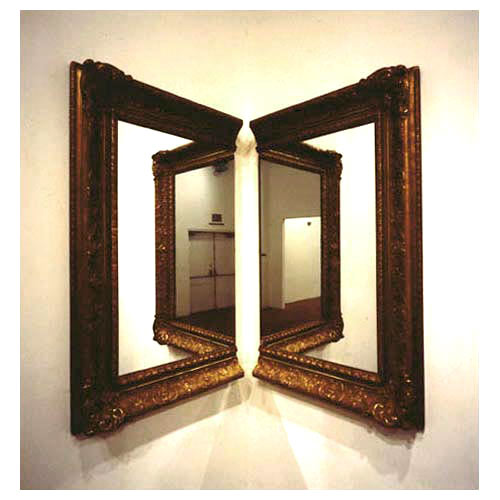Michelangelo Pistoletto: From One to Many, 1956-1974 curated by Carlos Basualdo, The Keith L. and Katherine Sachs Curator of Contemporary Art PHILADELPHIA MUSEUM OF ART, November 2, 2010 – January
curated by
Carlos Basualdo, The Keith L. and Katherine Sachs Curator of Contemporary Art
PHILADELPHIA MUSEUM OF ART, November 2, 2010 – January 16, 2011

Division and Multiplication of the Mirror, 1975-1978
Golden frame and mirror, two elements, cm 150 x 80 each
De Menil Collection, Houston – Photo: P. Hester
Michelangelo Pistoletto: From One to Many, 1956-1974 will present the work of one of the most influential living European artists whose work is increasingly gaining recognition in the United States as a founder of Arte Povera in the 1960s and a forerunner to contemporary participatory practices that have dominated the field since the mid-1990s. watch a video about the exhibition
The exhibition will be then presented at MAXXI (Museo nazionale delle arti del XXI secolo), in Rome (Italy), from March 4th to August 15th, 2011 (further information).
As the first focused survey of works by Pistoletto in this country in over two decades, the exhibition will place Pistoletto’s oeuvre in the context of the socio-cultural transformations of Italy and Western Europe in the post-war period as well as relate his work to the most important developments in American art since the 1960s—Pop Art, Minimalism and Conceptual Art.
Most importantly, it will emphasize the participatory aspect of his work that has structured his practice from the mid-1960s on.
Drawing from both American and European public and private collections, the presentation will include over 100 works of art, many of which have never been exhibited before in the United States. Pistoletto began exploring the tension between the individual human figure and the anonymous spectator at the beginning of his career.
After first portraying himself in his paintings, he then sought to include the spectator through the progressive use of increasingly reflective surfaces. In the "Quadri specchianti" ("Mirror Paintings"), which he created by gluing hand-painted figures onto mirroring surfaces of stainless steel, the artist incorporated the viewer’s reflected image into the work as a fundamental part of its experience.
By concentrating on the passage from the first self-portraits of the mid-1950s to the collaborative actions of the late 1960s and early 1970s, the audience will follow Pistoletto’s journey from a rigorous investigation of self-representation to the development of the creative collaborations that have since characterized his artistic practice.
The exhibition will also include sections devoted to Pistoletto’s "Plexiglass" works from 1964 that clearly prefigure Conceptualism, his Stracci (Rags) sculptures from the late-1960s and early-1970s that exemplify his Arte Povera period, and documentation of the performance work that he produced with his Zoo group from 1968 to 1970.
An extensive selection of "Mirror Paintings" from 1962 to 1974 will allow visitors to trace the evolution of the artist’s technique while mapping the sociopolitical changes in Italy during that period, which are clearly identifiable in Pistoletto’s progressive choice of subject matter.
A centerpiece of the show will be Pistoletto’s "Oggetti in meno" ("Minus Objects"), a group of sculptural objects created in 1965 and1966 in which the aesthetics of seriality and non-compositionality of Minimalism are purposefully contested by emphasizing the discrepancies between each individual work and by drawing inspiration from fields as diverse as artisanship, architecture, design, and popular culture.
As is the case for Pistoletto’s entire oeuvre, the connecting factor in the "Minus Objects" is never a predetermined artistic project or plan, but rather a reliance on improvisation, the artist’s deep knowledge and love of materials, and a passionate emphasis on singularity and difference rather than repetition and homogeny. The installation design of the exhibition will place all of these bodies of work in close dialogue with each other. Pistoletto’s "Mirror Paintings" will be distributed chronologically and will punctuate other series such as the Minus Objects and the Rags to elucidate Pistoletto’s clear artistic evolution and the impact of the cultural and political milieu in his practice.
Cittadellarte

Third Paradise workshop, Didactics and Art Office of Cittadellarte
Didactics
Pistoletto’s current project, Cittadellarte—whose name implies both a fortified enclave and city of art—will be represented in conjunction with Michelangelo Pistoletto: From One to Many, 1956-1974. The PMA and MAXXI will each present their own versions of Michelangelo Pistoletto: Cittadellarte that will reflect a close dialogue with the respective venues.
Cittadellarte is an interdisciplinary laboratory for art and cultural production, founded by Pistoletto in his hometown of Biella, Italy (near Turin) in 1998. There, Pistoletto has developed an institution organized around several autonomous and self-organized offices geared toward a multiplicity of topics such as Art, Economics, Education, Politics, Ecology, and Communication.
Clearly indebted to his participatory work of the mid to late 1960s, Cittadellarte places at the core of these diverse offices and the activities they offer Pistoletto’s firm commitment to an “art [that is] at the center of a responsible process of transformation of society.”
Therefore, Michelangelo Pistoletto: Cittadellarte will highlight the intellectual, political, and social dialogues fostered by Cittadellarte through an exhibition and associated program of activities that utilize the exhibition space as a social and educative forum.

Love Difference, Carribean Sea, 2005.
Sand, wood, aluminium, 709×357 cm. Photo: P.Terzi
The Cittadellarte installation at PMA will host a series of performances, lectures, and workshops bringing the innovative spirit of this artistic center to the Museum and the city of Philadelphia.
The offered activities will be centered on three central concerns of Cittadellarte: the Caribbean as a mediterranean sea, Love Difference, and Sustainability.
To Pistoletto, the etymology of Mediterranean—middle from “medi” and land from “terra”—articulates a concept of space that exists between lands, and therefore between people, defining in turn a locus for communication and exchange. Therefore the central elements of the Cittadellarte installation will be an array of tables in the shape of various seas, serving as both art objects and platforms for discussion.
Specifically focusing on the Caribbean, the Museum will work with educative institutions to develop classes and programming related to Caribbean culture. In addition, Love Difference will drive activities fostering tolerance; and, Sustainability will be applied to issues relating to the environment, economics, architecture, energy use, and recycling, among others.


Workshop Experience Love Difference, curated by Love Difference in collaboration with Art Museum of Philadelphia, 2010 November
All programming for Cittadellarte that will take place at PMA is being developed by the Museum’s Education department in close consultation with the Modern and Contemporary staff in the Curatorial Department, the artist, and staff members of Cittadellarte.
As part of the crucial exchanges between the Museum and Cittadellarte—and ultimately with the city of Philadelphia—members of the Education department have visited Cittadellarte to experience its program firsthand, and a member of Cittadellarte will travel to Philadelphia to participate in planning the programs alongside Education staff. The programming developed for Cittadellarte will afford an opportunity for the Philadelphia Museum of Art to work with grass roots organizations and to establish collaborations with other institutions in the city.
PHILADELPHIA ART MUSEUM PROGRAM:
SPECIAL FAMILY PROGRAM
CREATIVE APPROACHES TO SUSTAINABLE DEVELOPMENT, CONFERENCE, NOVEMBER 3-4, 2010
RELATED PROGRAMS
Exhibition Catalogue:
In conjunction with the exhibition, the Philadelphia Museum of Art will publish an illustrated catalogue edited by Carlos Basualdo, the Keith L. and Katherine Sachs Curator of Contemporary Art, with contributions by art historians Jean-François Chevrier, Claire Gilman, Gabriele Guercio, and Angela Vettese, as well as the Museum’s Conservator of Paintings Suzanne Penn.
The PMA’s catalogue will be in English only; MAXXI will use the Museum’s design to produce the Italian edition. Renowned designer Abbott Miller of Pentagram is designing the catalogue, which will be approximately 400 pages and will contain 130 color and 50 black-and-white illustrations.
The catalogue will include plates for all works on view, pairing the Mirror Paintings with documentary photos of the works installed and reflecting various, some historically significant, interiors. For the first time in a major catalogue, much of the source photography that Pistoletto used, manipulated, and replicated for his Mirror Paintings will be published in an effort to elucidate the artist’s process and relate it to his interest in staging and theater.
The Philadelphia Museum of Art will publish an English-language catalogue that will be distributed worldwide by Yale University Press, while MAXXI will produce an Italian-language catalogue with the same, or similar, design from Pentagram.
PRESS:
Thirty-fourth Street Magazine. By Inna Kofman
Illywords.com: by Anna Adriani
Delaware County Times. By Terry Conway
Mainline Times. By Bonnie Squires
Philadelphia City Paper. By Robin Rice
Montgomery County News: Art Matters. By Burton Wasserman
Broad Street Review. By Anne Fabbri
Philebrity
Rogerallen.net. by Roger Allen
Haute Living.com. By Melissa Auman Greiner
Vogue.com. by Ted Loos
Official links:
philamuseum.org
Michelangelo Pistoletto

